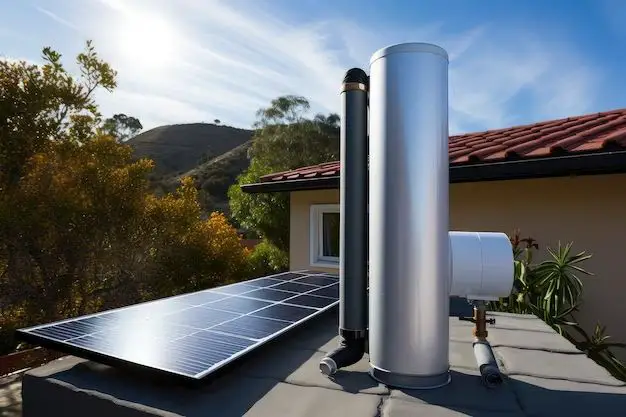Greenhouses allow gardeners to grow plants year-round by creating a warmer, more humid environment than outside. However, greenhouses still need additional heating during cold weather to keep plants healthy. Traditionally, greenhouse heaters have relied on gas, electricity, or other fossil fuels – but solar power offers a renewable alternative. Solar-powered heaters are an eco-friendly way to provide sufficient warmth for a greenhouse without generating greenhouse gas emissions.
Page Contents
How do solar-powered greenhouse heaters work?
Solar heaters for greenhouses work by collecting heat from the sun and transferring it indoors. There are two main types of solar-powered greenhouse heaters:
Passive solar heaters
Passive solar greenhouse heaters rely on the greenhouse structure itself to capture sunlight. The most common passive solar design uses materials like stone, concrete, or water tanks to absorb and store heat from the sun during the day. These materials release the stored solar heat at night to keep the greenhouse warm.
Passive solar designs also maximize sunshine entering the greenhouse using south-facing glazing, insulating curtain systems, and/or shutters to trap solar energy inside. While simple, passive solar greenhouses may not provide enough heat on their own during cold weather.
Active solar heating systems
Active solar heating uses panels, pumps, and fans to collect, store, and distribute solar thermal energy. Common active system designs include:
– Solar air heaters – These use dark metal absorbing plates to heat air, which is then blown into the greenhouse.
– Solar hydronic systems – These circulate a liquid like water or antifreeze through solar collectors and pipes. The stored solar heat is carried into the greenhouse through radiators or underfloor heating.
– Solar combi systems – These combine solar hydronic and solar air systems for maximum efficiency.
Properly designed active solar heating systems can offer reliable, sufficient heating for greenhouses even in cold climates.
What are the benefits of solar greenhouse heaters?
Solar-powered systems offer unique advantages over traditional greenhouse heating:
Renewable energy
Solar energy is endlessly renewable. Once installed, the fuel source for a solar heater – sunlight – is free. This helps reduce operating costs and reliance on finite fossil fuels.
Reduced carbon footprint
Unlike gas or electric heaters, solar systems generate heat without producing greenhouse gas emissions. Solar energy doesn’t create air pollution.
Energy independence
Generating your own power on-site with solar collectors means you don’t have to rely on external utility companies for electricity or gas.
Lower costs
While upfront installation costs are higher, the long-term savings from free solar fuel can make solar heaters more economical in the long run. Maintenance costs are also low.
Solar incentives and tax credits
State/federal solar incentives like rebates, tax credits, and renewable energy credits (RECs) can further offset the upfront costs of solar thermal systems.
Versatility
In addition to heating the greenhouse, solar collectors can provide hot water and electricity.
What factors should you consider when choosing a solar greenhouse heater?
Selecting the right solar heating system for your needs depends on:
Your climate
The amount of winter sunlight and severity of temperatures will determine how much heating power your system needs. Passive solar may suffice in warmer climates, while colder regions need active heating with solar thermal collectors properly sized for your square footage.
Greenhouse size and design
Scale your solar system to match the size of your greenhouse. Layout also matters – passive solar greenhouses should have south-facing glazing for maximum light exposure.
Nighttime heat retention
To hold in solar heat at night, your greenhouse needs thick insulation, thermal curtains, or other heat retention methods.
Supplemental heating needs
In overcast conditions or extreme cold, a backup electric or gas heating system helps maintain optimal temperatures.
Your budget
While long term savings can be significant, solar heaters have higher upfront costs than gas or electric heaters. Any incentives or tax credits can help offset this initial investment.
DIY vs professional installation
Those with solar thermal expertise can self-install simpler passive or solar air heating systems. More complex active systems, like solar hydronics, require professional expertise.
What are some top solar heater products for greenhouses?
Some well-reviewed solar heating systems for greenhouses include:
APJ-500 Solar Greenhouse Heater

– 500 watt solar air heater panel
– Suitable for greenhouses up to 300 sq ft
– Thermostatically controlled fan for distribution
– Wall or roof mounted
– DIY installation
SunQuest 250 Solar Hot Water Collector Panel

– Evacuated tube solar collector
– Efficient liquid heating for solar hydronic systems
– 250 watt panel
– Professional installation recommended
Jeda SolarCombi Greenhouse Heating System

– Combined solar air and solar hydronic heating
– Customizable based on greenhouse size
– Maximum efficiency with dual-function
– Professional installation required
– Eligible for tax credits
Conclusion
Solar-powered heaters offer an eco-friendly, renewable way to heat greenhouses. Passive solar designs or active solar collectors can provide sufficient warmth while minimizing energy costs. With proper sizing and installation, solar thermal systems are a smart heating solution for any climate. State/federal incentives make solar heaters even more affordable over the long term. Talk to solar professionals to find the right solar heating system for your greenhouse needs.
